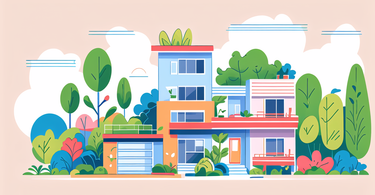The Challenges of Gardening in Urban Settings
Assessing Your Limited Space
Urban gardening often means working with smaller areas. Start by measuring your space. Look for unused spots like windowsills, balconies, or rooftops. Consider vertical space on walls or fences. Every inch counts in urban gardens. Think creatively about where plants can grow. Even a sunny corner can become a mini garden. Remember to check local rules about outdoor spaces. Some buildings have restrictions on balcony use. Plan your garden layout carefully to maximize the area. Use graph paper to sketch ideas before planting. This helps you make the most of your limited urban space.

Navigating the Unique Climate of Cities
Cities have their own microclimates. Buildings create wind tunnels and heat islands. This affects plant growth. Learn about your area's specific conditions. Check the amount of sunlight your space gets throughout the day. Urban areas often have less direct sun due to tall buildings. Air quality can also impact plants. Choose species that thrive in city conditions. Consider factors like pollution tolerance and wind resistance. Many plants adapt well to urban environments. Research which ones suit your specific city climate best. Local nurseries can offer advice on plants that do well in your area.
Balancing Aesthetics and Functionality in Small Spaces
In small urban gardens, every plant should serve a purpose. Choose plants that look good and are useful. Herbs are both attractive and practical for cooking. Dwarf fruit trees can provide beauty and food. Use colorful planters to add visual interest. Arrange plants at different heights for depth. Mix textures and colors for an appealing look. But don't overcrowd your space. Leave room for movement and maintenance. Consider multi-functional furniture like storage benches. These can hold gardening tools while providing seating. Aim for a balance between beauty and practicality in your urban garden design.
Creative Solutions for Urban Gardening
Utilizing Vertical Spaces and Planters
Vertical gardening is key in urban spaces. Use wall-mounted planters to grow upwards. Trellises and hanging baskets maximize space. Try pocket planters for herbs or small flowers. Stackable containers create levels of greenery. Pallets can be repurposed into vertical gardens. For larger plants, use tiered plant stands. Window boxes bring nature to your view. Vertical hydroponics systems are great for leafy greens. Don't forget about indoor spaces. Use macramé hangers for plants inside. Wall-mounted shelves can hold small pots. Vertical gardens also act as natural room dividers. They add privacy and greenery to your urban home.

Innovative Gardening Techniques and Tools
Urban gardeners can use many clever techniques. Try square foot gardening to maximize yield. This method divides space into small, manageable sections. Hydroponic systems grow plants without soil. They're perfect for indoor or balcony gardens. Aquaponics combines fish and plant growth. It's a sustainable way to produce food in small spaces. Use self-watering planters for low-maintenance gardening. Compact composters turn kitchen scraps into plant food. Folding tools save space in small storage areas. Look for multi-purpose gardening gadgets. These can combine several tools in one. Smart plant sensors help monitor soil and light conditions. They connect to your phone for easy plant care.
The Importance of Sustainability and Eco-Friendly Practices
Urban gardens should focus on sustainability. Use organic methods to avoid harmful chemicals. Collect rainwater for irrigation when possible. Install a small rain barrel on balconies or patios. Compost kitchen scraps to reduce waste and feed plants. Choose native plants that need less water and care. They also support local wildlife like birds and bees. Use recycled materials for planters and structures. Old tires, wooden crates, and plastic bottles work well. Practice companion planting to naturally deter pests. This reduces the need for pesticides. Create habitats for beneficial insects like ladybugs. They help control garden pests naturally. Consider joining a community garden for shared resources.
Case Studies: Successful Urban Gardening Projects
Inspiring Profiles of Urban Gardening Enthusiasts
Meet Sarah, a New York apartment dweller. She transformed her fire escape into a thriving herb garden. Sarah uses vertical planters and hanging baskets. Her small space now provides fresh herbs year-round. In London, Tom converted his tiny balcony into a vegetable patch. He uses a combination of container gardening and vertical systems. Tom grows tomatoes, peppers, and leafy greens in just 20 square feet. Maria in Tokyo practices indoor hydroponic gardening. She grows lettuce and microgreens in her small kitchen. These urban gardeners show what's possible with creativity and dedication. They inspire others to start growing in limited city spaces.

Analysis of Thriving Urban Gardens
Successful urban gardens share common traits. They make efficient use of available space. Vertical gardening is often a key feature. Many use multi-functional elements like edible landscaping. Thriving gardens often incorporate water-saving techniques. Drip irrigation and mulching are common practices. Successful urban gardeners choose plants suited to local conditions. They often focus on high-yield, compact varieties. Many urban gardens use companion planting for pest control. This reduces the need for chemical interventions. Soil health is a priority in thriving city gardens. Composting and organic fertilizers are widely used. These gardens often serve multiple purposes beyond food production. They create beauty, reduce stress, and improve air quality in urban areas.
Lessons Learned from Urban Gardening Pioneers
Urban gardening pioneers offer valuable insights. Start small and expand gradually. This helps you learn and adapt your methods. Be flexible and willing to experiment. What works in one space may not work in another. Pay attention to light conditions throughout the day. This is crucial for plant placement and selection. Learn to maximize vertical space creatively. Even walls and railings can become growing areas. Don't underestimate the importance of soil quality. Good soil is the foundation of a healthy garden. Network with other urban gardeners for support and ideas. Join local gardening groups or online forums. Be patient and persistent. Urban gardening has unique challenges, but the rewards are worth it. Remember that every small green space contributes to urban ecology. Your garden can make a difference in your city's environment.
